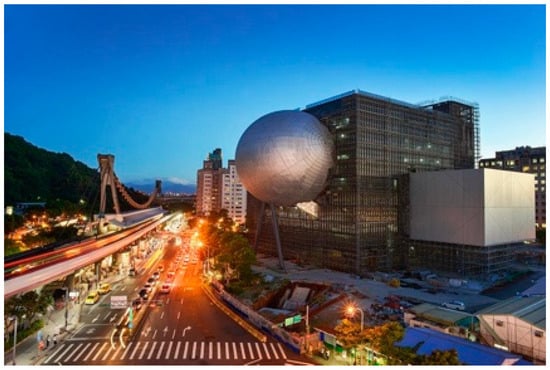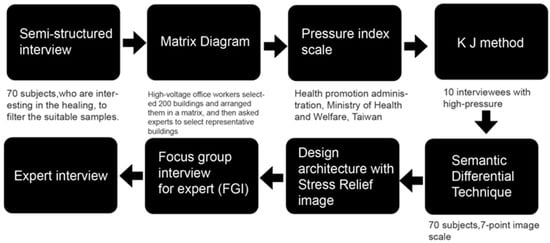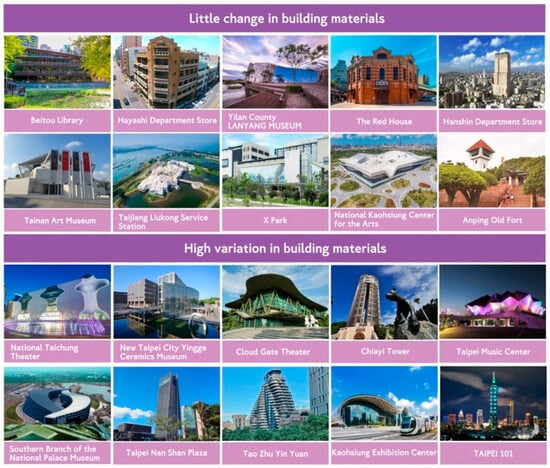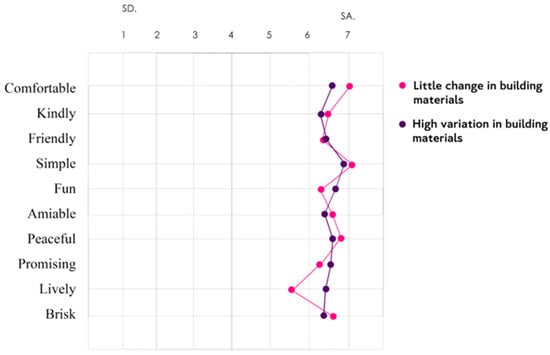Abstract
Due to rapid urbanization, high-density cities have become a dominant human habitat, and sustainable urban development has become a key concept in urban governance. Thus, it is important to understand the impact of visual elements in urban architecture on stress to make accurate and practical planning and strategies for healthy and sustainable living environments. We examined the designs and features of building facades that alleviate stress and identified measuring metrics for stress relief in viewers. We selected 20 Taiwanese-style public buildings for the examination. To understand the relationship between architecture and stress relief, 70 participants were interviewed in a semi-structured method after showing images of the 20 buildings. We used the semantic differential method and a 7-point image scale to rate stress relief from various architectural styles. The participants found the use of multiple materials or lighting in public buildings interesting but not stress-relieving. A greater amount of cooler and heavier materials made of iron in the building exterior increased stress. This finding offers insights into planning and developing sustainable and psychologically supportive urban environments.
1. Introduction
City planners and society increasingly recognize the importance of the ecosystem in sustainable urban development. Spaces require services related to the ecosystem for recreation, aesthetics, and spiritual experiences [1]. Therefore, it is essential to evaluate the aesthetic elements that impact the delivery of cultural ecosystem services in architecture. These factors are distinct from others as they demand on-site experience and directly affect human well-being [2].
Stress Reduction Theory (SRT) is a theory of environmental psychology that explains the relationship between environmental exposure and mental stress [3]. High-density cities have become dominant in urban habitats worldwide due to rapid urbanization over the past decade. Research suggests that high-density urban landscapes are more oppressive than low- or medium-density urban landscapes [4]. In this study, we examined the public buildings in Taiwan, focusing on stress relief and perceived safety. In this research, office workers from high-stress groups were interviewed after work to find (1) what public building features citizens like, (2) if the preference is consistent in different visitor needs (e.g., overall preference, stress relief, and perceived safety), (3) if diverse materials and building envelopes are important factors influencing user preferences, and (4) if importance varies based on different needs, such as stress relief and perceived safety. Different preferences are expected for public buildings related to different needs. Thus, we hypothesized that a variety of materials and building facades are important influencing factors depending on citizen needs.
2. Quality of Life and City Sustainability
2.1. Correlation between High-Density Cities and Mental Stress
In urban development, quality of life is defined in three dimensions. The first dimension relates to personal aspects, such as overall happiness and satisfaction with the city. Therefore, individuals hope to fulfill their physiological needs such as drinking, eating, and sleeping, as well as obtain necessities such as housing and adequate income. Therefore, we examined the collective dimension of an individual’s social and economic position in the community [5,6]. This dimension refers to a sense of belonging to society, which is positively or negatively related to an individual’s social circumstances [7]. Additionally, the material dimension is defined as goods and services in sufficient quality and quantity [8]. Access to goods and services of sufficient quantity and quality enables individuals to meet their needs, including transportation, health, education, leisure, and culture [9]. This discussion will cover the city’s offerings.
Ulrich et al. [10] proposed SRT and argued that natural environments reduce mental stress while artificial environments induce it. Although this theory has been referred to by researchers, its application was controversial in artificial environments, with most focusing on natural environments or materials. The theory suggests that urban density is positively correlated with mental stress. In urban areas, individuals are frequently exposed to buildings, which substantially impacts their mental well-being.
Architecture is crucial in populated cities and contributes to depression [11]. Although many studies have examined the effect of natural elements in cities on citizen stress, none have yet explored the potential correlation between artificial elements in cities and mental stress. According to Asgarzadeh et al. [12,13], individuals essentially have a form of negative psychological stress. Crowded environments can weaken people’s self-control, leading to mental stress [14,15].
2.2. Quality of Life and Architectural Development
The definition of quality of life in an urban environment varies depending on the country, region, and the physical and social circumstances of an individual [3]. Although such statements often refer to residents’ satisfaction with their city, the assessment methods can vary. Researchers use qualitative methods and scales to measure personal perceptions and satisfaction. Quantitative methods are also used with indicators such as wealth, affordability, health, quality, and safety of access to services. Urban quality of life indices derived from these methods differ according to measures of an individual’s ability to survive and thrive as a result of the economic, social, and urban solutions provided by the city [3]. The quality of life is greatly influenced by the quality of the city. Therefore, it is important to ensure that cities are well-organized and designed to promote the well-being of citizens. Cluttered cities can exacerbate psychological stress among residents.
At the socioeconomic level, studies attribute the quality of life in urban environments to the provision of an economic, social, and urban framework that is conducive to human activities. Tan et al. [16] have suggested that the quality of urban life improves with changes in social development, which increases opportunities for high-paying jobs or changes and enables individuals to afford or pursue better housing and other facilities, thereby improving their quality of life [17]. Interest in post-work quality of life is growing. Thus, after-work classes and yoga practices for relaxation are increasing. Additionally, cultural, spiritual, and community attachment are important in determining the quality of urban life. Local traditions and architecture enhance the vitality of urban life and increase personal satisfaction [3]. Simultaneously, a strong sense of community attachment enhances social cohesion and resilience to maintain urban sustainability and quality of life [3]. This, in turn, affects the competition and comparison of urban architectural appearance. Ultimately, a livable city depends not only on economic factors but also on the mental well-being of its residents, better access to various social services such as hospitals and doctors, and a generally well-educated population [3]. Therefore, under such circumstances, the improvement in the urban environment becomes even more important.
2.3. Visual Complexity of Buildings
The term ‘message’ has different meanings depending on the context [18]. In the case of buildings in the city, changes in appearance convey the design concept. In neuroscience, the term is often used to refer to stimulus encoding, decision making, and memory storage. In an urban context, what citizens see can be interpreted as a form of messaging, such as the appearance of buildings and crowded streets (Figure 1). This can lead to psychological stress for individuals. The brain receives messages from multiple sensory channels to process stimuli. The key challenge is to capture people’s attention with only relevant information. Objectivity must be maintained, and subjective judgment must be excluded. However, it is worth noting that information that does not meet this standard is behaviorally relevant. This highlights the complexities and pressures that communicating large or complex messages can have on public reception.

Figure 1.
Taipei Performing Arts Center building’s exterior with a variety of materials.
The term ‘visual complexity’ in architecture refers to the level of detail or intricacy that influences people’s perception [19,20]. This means that excessive details enhance visual complexity but they also overwhelm the viewer with too much information. Berlyne [21,22] has suggested that a high degree of visual complexity holds people’s attention for longer periods. However, it is crucial to balance visual complexity and the amount of information presented. Therefore, it is essential to present information clearly and concisely, avoiding sprawling descriptions and complex terminology. Nasar [23] defined visual complexity as ‘diversity’ and evaluated the visual quality of residential scenes through surveys based on objective assessment. It is important to use precise terminology when discussing visual complexity and avoid decorative language. In other words, the more complex the appearance of a building, the longer citizens pay attention to it, and the greater the psychological pressure to be caused. This is because the brain requires more time to process complex information.
3. Methodology
3.1. Survey Method
Various studies confirmed that exposure to a natural urban environment led to positive changes in mood and stress reduction as well as a lower heart rate compared to the built environment. Thus, it is needed to make the building relieve the pressure on the citizens. Due to the purpose of the present research and the basis of existing theory, we adopted experimental methods to investigate the stress-relieving building facade.
In past research, we used experimental methods to obtain the subject’s views on the decompression structure to obtain the participants’ feelings. Therefore, in this study, we used the same research method to examine the impact of the quantity of building materials on high-stress people. For each of the 70 participants, we analyzed their perceptions of stress relief and pressure and investigated how each perception was related to previous and subsequent thoughts and external stimuli. The decompression index of 30 buildings was evaluated through the Decompression Building Scale.
3.2. Participants
To examine the influence of building exterior materials on individuals experiencing high levels of stress, we analyzed the impact of building materials on psychological stress. We recruited 70 Taiwanese office workers, aged 35 on average, with at least 5 years of work experience (Table 1). Semi-structured interviews were conducted individually in the same room. During the interviews, each participant was shown ten architectural images aimed at relieving stress and was interviewed for forty minutes. The selected sample buildings were shown, and participants chose buildings they had seen in person, online, or in their daily lives. These public buildings are located in Taiwan, a culture familiar to the participants.

Table 1.
Participants in this study.
We asked 10 experts in architectural design to select representative and relatively stress-relieving buildings from these two types of buildings (Table 2). We used a stress index scale (Health Promotion Agency, Taiwan Ministry of Health and Welfare) to select 10 office workers who showed a stressful lifestyle from the previous 70 participants (Table 3). These 10 participants selected 523 stress relief-related adjectives during a KJ method screening process.

Table 2.
List of experts.

Table 3.
High-stress assessors.
3.3. Procedure
We obtained the subject’s views and feelings on the decompression structure by collecting data on buildings with Taiwanese cultural characteristics for investigation (Figure 2). Each participant was assigned to observe two types of buildings (buildings with more than three materials and less than three materials). Participants chose one of three constructive conditions including (1) no stimuli available (after observation, participants were given only a brief overview of the building’s design, e.g., location, building name, and designer’s name), (2) restricted access to stimuli (participants have access to the stimulus search tool, but only once per session, i.e., using web pages to retrieve material), and (3) unlimited access to stimuli (we used the search tool multiple times within the access time limit). Then, we studied the stress-relieving architectural choices for the participants. We asked for the judgment of the participants in a short period to obtain the true feelings of the participants

Figure 2.
Study procedure.
3.4. Data Analysis
If individuals are exposed to a high-stress environment, either in their personal or professional lives, they may experience cognitive overload and fatigue due to the abundance of visual information. This information can be overwhelming, particularly during the initial stages of reception. Similarly, excessive information, such as overly complex building designs, can cause stress for residents, especially when these elements interact. Simpler buildings are easier to handle and provide a stress-relief effect for residents. In this study, 70 participants assessed stress by using the Stress Index Scale provided by the Department of Health Promotion, Ministry of Health and Welfare, Taiwan. Ten participants showed high scores for stress in the Jiro Kawakita (KJ) method. The top five words expressed by the participants were ‘comfortable’, ‘kind’, ‘friendly’, ‘simple’, and ‘fun’ (Table 4).

Table 4.
Top five attractive feelings.
These two types of buildings have a massive amount of exterior materials. After discussions with experts, more types of different materials were defined to assess the degree of viewers’ stress.
In testing, we first selected people who visited test sites (Figure 3). In total, 70 participants (40 women) were office workers. We briefed the evaluation process and asked the participants to choose an adjective or preference to express their feelings about the images to reduce the chances for them to assess the scale of the buildings. After the participants saw the slides for 60 s, they rated the degree of stress reduction (Figure 4). The test results showed that most participants believed that the fewer materials used in the building’s exterior, the more stable and relaxing they felt. The more natural the material was, the more comfortable they felt too.

Figure 3.
Twenty test buildings.

Figure 4.
Measurement results of two types of buildings.
4. Discussions
The buildings in cities are shaped by perception-based characteristics such as material, color, shape, form, light, and size [24]. Materials show details [24,25], encapsulating contours and compositions [24,26,27]. Colors reflect the structure of different tones in the scene [24,28]. Material, shape, and color are considered to be the most basic visual elements that represent the built environment [28]. According to Lynch [29], the shape, color, and arrangement of urban environments contribute to the formation of clear and useful mental images, including details such as materials and shapes.
During the COVID-19 pandemic, architectural types were especially associated with stress relief. People’s emotions are affected by what they see. Excessive material on the exterior of buildings increases the amount of information, which affects the emotional response of the people. During COVID-19, people were forced not to move around the city. If they saw buildings with many materials from the windows, it affected emotions and reactions. When they walked around, they were more affected. Therefore, people consider the current development and urban form for the judgment standard that is affected by the spiritual interests of citizens. Architecture relieves stress and improves mental health if it is designed with consideration for the spatial environment [30]. It is required for buildings to create a positive atmosphere especially for patients as visual surroundings can significantly impact their mood.
5. Conclusions
Currently, over 50% of the world’s population resides in urban areas globally, and the number will increase to 70% by 2050. Despite the increase in urban building and population density, living in cities is linked to higher risks of mental health issues compared to rural areas. For instance, individuals living in cities have an almost 40% higher risk of depression, which is double that of schizophrenia. Anxiety, stress, and isolation are more often observed [31]. This indicates that cities need to exert the most significant psychological pressure on individuals from a social, cultural, or economic perspective. The most immediate form of pressure is visual. Therefore, when creating environments, designers must consider design elements that reduce the impact of external factors on the reception of information.
This study was conducted based on the experience of the participants and their perceptions of building materials. The findings in this study suggested that buildings with excessive decoration and detail are fascinating but cause stress. Too many decorations on buildings overwhelm people with excessive information. Thus, multi-feature visual complexity is required for urban renewal. For instance, when renewing historical streetscapes, the principle of preserving urban memory is required. Instead of reproducing each element in an imitative manner, multi-feature visual complexity is used for buildings, facilities, or furniture to maintain a similar level of complexity by using surface materials with similar textural complexity. It is important to consider the residents’ well-being. In the past, urban architecture was often developed solely according to the designer’s aesthetics but emphasis was put on functionality and livability recently. It is necessary to include more designs and materials. The building must be isolated from its environment to conduct more organized experiments. We used software to remove things other than buildings in images. The participants were influenced by environmental impressions when judging materials were changed. Therefore, they had different opinions based on their imaginations. However, it was still possible to examine the stress-relieving building’s materials. That is, individuals’ judgments of material changes depended in part on their mood. There are various emotions involved in these judgments being affected by changes in the environment.
Author Contributions
Conceptualization, M.-C.H. and Y.-C.C.; investigation, Y.-C.C. and Y.-J.J.; methodology, Y.-C.C. and J.-C.T.; writing—original draft, Y.-C.C.; writing—review and editing, Y.-C.C. All authors have read and agreed to the published version of the manuscript.
Funding
This research received no external funding.
Institutional Review Board Statement
Not applicable.
Informed Consent Statement
Not applicable.
Data Availability Statement
Data sharing is not applicable due to privacy.
Conflicts of Interest
The authors declare no conflict of interest.
References
- Daniel, T.C.; Muhar, A.; Arnberger, A.; Aznar, O.; Boyd, J.W.; Chan, K.M.A.; Costanza, R.; Elmqvist, T.; Flint, C.G.; Gobster, P.H.; et al. Contributions of cultural services to the ecosystem services agenda. Proc. Natl. Acad. Sci. USA 2012, 109, 8812–8819. [Google Scholar] [CrossRef] [PubMed]
- Hegetschweiler, K.T.; de Vries, S.; Arnberger, A.; Bell, S.; Brennan, M.; Siter, N.; Olafsson, A.S.; Voigt, A.; Hunziker, M. Linking demand and supply factors in identifying cultural ecosystem services of urban green infrastructures: A review of European studies. Urban For. Urban Green. 2017, 21, 48–59. [Google Scholar] [CrossRef]
- ESPON. ESPON QOL—Quality of Life Measurements and Methodology; Final Report; ESPON: Luxembourg, 2020. [Google Scholar]
- Luo, Y. Gender and job satisfaction in urban China: The role of individual, family, and job characteristics. Soc. Indic. Res. 2016, 125, 289–309. [Google Scholar] [CrossRef]
- Costanza, R.; Fisher, B.; Ali, S.; Beer, C.; Bond, L.; Boumans, R.; Snapp, R. Quality of life: An approach integrating opportunities, human needs, and subjective well-being. Ecol. Econ. 2007, 61, 267–276. [Google Scholar] [CrossRef]
- Santos, L.D.; Martins, I.; Brito, P. Measuring subjective quality of life: A survey to Porto’s residents. Appl. Res. Qual. Life 2007, 2, 51–64. [Google Scholar] [CrossRef]
- Mouratidis, K. Urban planning and quality of life: A review of pathways linking the built environment to subjective well-being. Cities 2021, 115, 103229. [Google Scholar] [CrossRef]
- Mouratidis, K. Commute satisfaction, neighbourhood satisfaction, and housing satisfaction as predictors of subjective well-being and indicators of urban livability. Travel Behav. Soc. 2020, 21, 265–278. [Google Scholar] [CrossRef]
- Mouratidis, K. Compact city, urban sprawl, and subjective well-being. Cities 2019, 92, 261–272. [Google Scholar] [CrossRef]
- Ulrich, R.S. Effects of interior design on wellness: Theory and recent scientific research. J. Health Care Inter. Des. 1991, 3, 97–109. [Google Scholar]
- Asgarzadeh, M.; Koga, T.; Yoshizawa, N.; Munakata, J.; Hirate, K. A transdisciplinary approach to oppressive cityscapes and the role of greenery as key factors in sustainable urban development. In Proceedings of the 2009 IEEE Toronto International Conference Science and Technology for Humanity (TIC-STH), Toronto, ON, Canada, 26–27 September 2009. [Google Scholar]
- Asgarzadeh, M.; Koga, T.; Hirate, K.; Farvid, M.; Lusk, A. Investigating oppressiveness and spaciousness in relation to building, trees, sky and ground surface: A study in Tokyo. Landsc. Urban Plan. 2014, 131, 36–41. [Google Scholar] [CrossRef]
- Asgarzadeh, M.; Lusk, A.; Koga, T.; Hirate, K. Measuring oppressiveness of streetscapes. Landsc. Urban Plan. 2012, 107, 1–11. [Google Scholar] [CrossRef]
- Cohen, S. Aftereffects of stress on human performance and social behavior: A review of research and theory. Psychol. Bull. 1980, 88, 82–108. [Google Scholar] [CrossRef] [PubMed]
- Fleming, I.; Baum, A.; Weiss, L. Social density and perceived control as mediators of crowding stress in high-density residential neighborhoods. J. Personal. Soc. Psychol. 1987, 52, 899–906. [Google Scholar] [CrossRef]
- Tan, Z.; Shi, F.; Zhang, H.; Li, N.; Xu, Y.; Liang, Y. Household income, income inequality, and health-related quality of life measured by the EQ-5D in Shaanxi, China: A cross-sectional study. Int. J. Equity Health 2018, 17, 1–10. [Google Scholar] [CrossRef]
- Glaeser, E. Cities, productivity, and quality of life. Science 2011, 333, 592–594. [Google Scholar] [CrossRef]
- Adriaans, P. Information. In Standford Encyclopedia of Philosophy; Zalta, E.N., Ed.; Stanford University: Stanford, CA, USA, 2012. [Google Scholar]
- Posner, M.I.; Snyder, C.R.R. Attention and cognitive control. In Information Processing and Cognition: The Loyola Symposium; Solso, R.L., Ed.; L. Erlbaum Association: Hillsdale, NJ, USA, 1975; pp. 55–82. [Google Scholar]
- Snodgrass, J.G.; Vanderwart, M. A standardized set of 260 pictures: Norms for name agreement, image agreement, familiarity, and visual complexity. J. Exp. Psychol. Hum. Learn. Mem. 1980, 6, 174–215. [Google Scholar] [CrossRef]
- Berlyne, D.E. Conflict, Arousal, and Curiosity; McGraw-Hill Book Company: New York, NY, USA, 1960. [Google Scholar]
- Berlyne, D.E. Novelty, complexity, and hedonic value. Percept. Psychophys. 1970, 8, 279–286. [Google Scholar] [CrossRef]
- Nasar, J.L. Perception and evaluation of residential street scenes. In Directions in Person-Environment Research and Practice; Nasar, J.L., Preiser, W.F.E., Eds.; Ashgate Publishing Ltd.: Surrey, UK, 1999; pp. 229–247. [Google Scholar]
- Stamps, A.E. Psychology and the Aesthetics of the Built Environment; Springer Science & Business Media: Berlin/Heidelberg, Germany, 2013. [Google Scholar]
- Cooper, J.; Oskrochi, R. Fractal analysis of street vistas: A potential tool for assessing levels of visual variety in everyday street scenes. Environ. Plann. Plann. Des. 2008, 35, 349–363. [Google Scholar] [CrossRef]
- Guan, F.; Fang, Z.; Wang, L.; Zhang, X.; Zhong, H.; Huang, H. Modelling people’s perceived scene complexity of real-world environments using street-view panoramas and open geodata. ISPRS J. Photogrammetry Remote Sens. 2022, 186, 315–331. [Google Scholar] [CrossRef]
- Liu, Z.; Ma, X.; Hu, L.; Lu, S.; Ye, X.; You, S.; Tan, Z.; Li, X. Information in streetscapes—Research on visual perception information quantity of street space based on information entropy and machine learning. ISPRS Int. J. Geo-Inf. 2022, 11, 628. [Google Scholar] [CrossRef]
- Rossetti, T.; Lobel, H.; Rocco, V.; Hurtubia, R. Explaining subjective perceptions of public spaces as a function of the built environment: A massive data approach. Landsc. Urban Plann. 2019, 181, 169–178. [Google Scholar] [CrossRef]
- Lynch, K. The Image of the City; MIT Press: Cambridge, UK, 1964. [Google Scholar]
- DuBose, J.; MacAllister, L.; Hadi, K.; Sakallaris, B. Exploring the Concept of Healing Spaces. HERD Health Environ. Res. Amp Des. J. 2018, 11, 43–56. [Google Scholar] [CrossRef] [PubMed]
- Gruebner, O.; Rapp, M.A.; Adli, M.; Kluge, U.; Galea, S.; Heinz, A. Cities and mental health. Dtsch. Arztebl. Int. 2017, 14, 121. [Google Scholar] [CrossRef] [PubMed]
Disclaimer/Publisher’s Note: The statements, opinions and data contained in all publications are solely those of the individual author(s) and contributor(s) and not of MDPI and/or the editor(s). MDPI and/or the editor(s) disclaim responsibility for any injury to people or property resulting from any ideas, methods, instructions or products referred to in the content. |
© 2024 by the authors. Licensee MDPI, Basel, Switzerland. This article is an open access article distributed under the terms and conditions of the Creative Commons Attribution (CC BY) license (https://creativecommons.org/licenses/by/4.0/).